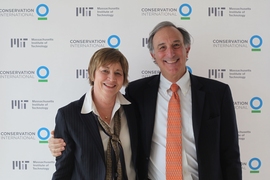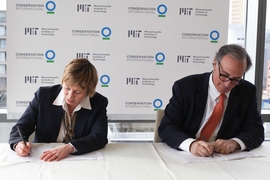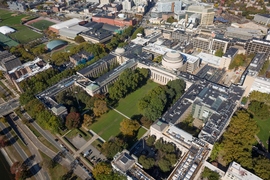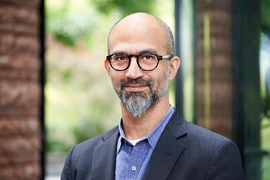MIT and Conservation International (CI) will participate in a multiyear collaboration to develop and advance nature-based solutions to global climate change, through research, education, and outreach efforts, the organizations announced today.
The collaboration brings together MIT’s technical, scientific, and engineering expertise with Conservation International’s expansive environmental programs, to look for ways that forests, coastal ecosystems, and urban areas can be managed to mitigate greenhouse gas emissions and adapt to climate change.
The collaboration launches today with a one-day hackathon at MIT that invites participants to team up on ideation and early-state design of nature-based, technologically savvy solutions to climate challenges in developing world communities. The collaboration will involve MIT students in CI’s international fieldwork and will initially include four joint research projects in which scientists will focus directly on climate challenges already having an impact in places such as the Philippines and the Amazon Basin.
The collaboration was established by MIT’s Office of the Vice President for Research and will be managed by MIT’s Environmental Solutions Initiative (ESI). ESI Director John E. Fernández, a professor of building technology in the Department of Architecture, says the collaboration is unique in its focus on “surprising, novel, and untested applications of science and engineering in the field of conservation.” MIT President L. Rafael Reif is also a member of CI’s board of directors
“We feel there is significant potential value in linking different disciplines and perspectives, for example engineering with ecology, while leveraging advances in big-data analysis, machine learning, and artificial intelligence to address the priorities and goals of conservation in ways that may not have been considered before this,” Fernández says.
“CI is thrilled to be part of this pioneering collaboration with the world’s premier scientific and engineering institute for research and learning,” says Daniela Raik, senior vice president and managing director at Conservation International. “Together we can design and implement innovative solutions to real-world challenges around the globe.”
MIT and CI began exploring a potential collaboration last year, with two key workshops held April 25 and July 26 that brought together MIT faculty and staff and the scientific leadership of Conservation International. At the meetings, participants discussed ways to use science and engineering to unlock the full potential of natural systems in storing climate-warming carbon emissions and helping communities adapt to climate change’s impacts, such as flooding and food insecurity.
“Nature plays a critical role in helping society offset the impacts of climate change,” says Raik. “For instance, tropical forests and other ecosystems can provide at least 30 percent of the mitigation needed to achieve the 2 or 1.5 degree [Celsius] targets that were set in the Paris Agreement last year.”
The groups agreed to focus their efforts on the interface between human activity and natural systems, as an important source of solutions to address climate change. CI has worked at this human-nature interface for decades, says Fernández, in multiple field offices that develop conservation plans in the context of local governmental, economic, social, and cultural systems.
“At the core of MIT’s climate action plan is the idea that we can have a much bigger real-world impact if we engage with other organizations, and this collaboration with Conservation International exemplifies that idea,” says Maria T. Zuber, MIT’s vice president for research. “Together, our goal is to move from education and research to the implementation of solutions that harness nature to both mitigate climate change and help communities around the world prepare for its impacts.”
The MIT-CI collaboration will include new educational and outreach activities. For MIT students, that could mean traveling to CI field sites in the Americas, Asia, Africa, and the Pacific Oceanscape to do hands-on work on local environmental projects alongside local stakeholders. A Student Action Corps will provide students with opportunities to engage public audiences on climate issues and solutions through blog posts, op-eds, and other digital and print communications.
Education and outreach activities will also include guest lectures at MIT by CI scientists as well as other shared teaching opportunities; postdoctoral fellowships; workshops for researchers from developing countries; class materials for K-12 students; crowdsourcing contests powered by MIT’s Climate CoLab platform; annual symposia; and a joint, web-based public portal on nature-based solutions to climate mitigation and adaptation.
The first research projects planned for the MIT-CI collaboration will pair ongoing CI field office work with extensions of studies already underway by MIT researchers. In one project, for instance, Heidi M. Nepf, the Donald and Martha Harleman Professor in the MIT Department of Civil and Environmental Engineering, will work with CI scientists to further develop a model of mangrove strength and the effects of wave drag and turbulence on key plants. While mangrove forests could be used as important “green infrastructure” to protect coastal areas, governments and engineers have been slow to adopt their conservation and management without more data on how mangroves could best be deployed to protect communities from severe flooding and erosion.
The Nepf lab will develop and test its model through CI’s field offices in the Visayas region of the central Philippines, the site of severe damage by Typhoon Haiyan in 2013. CI is already working with the national and local governments on mangrove forest restoration in the area.
"I am excited to work with Dr. Emily Pidgeon at CI, who is an international leader and advocate in coastal zone conservation for carbon mitigation and natural coastal defense,” Nepf says. “The MIT-CI collaboration will greatly expand the reach of my research with Dr. Maria Maza, facilitating better design of natural defense and more precise evaluation of carbon sequestration for proposed mangrove restoration projects.”
Altogether, planned MIT-CI research projects will involve numerous departments, labs, and programs at MIT, and will explore topics including the use of sensors to monitor natural resources; the social, economic, and environmental impact of climate adaptation efforts in developing countries; and how natural ecosystems provide for urban needs.
The new collaboration also supports MIT’s five-year Plan for Action on Climate Change, especially with regard to the plan’s goal of engaging with other organizations to advance research into solutions to mitigate and adapt to climate change, Fernández says. “We see this collaboration as a way to bring the deep expertise in engineering and other fields at MIT to opportunities for nature-based solutions to climate change that may not have been part of the MIT community’s focus before this.”
















